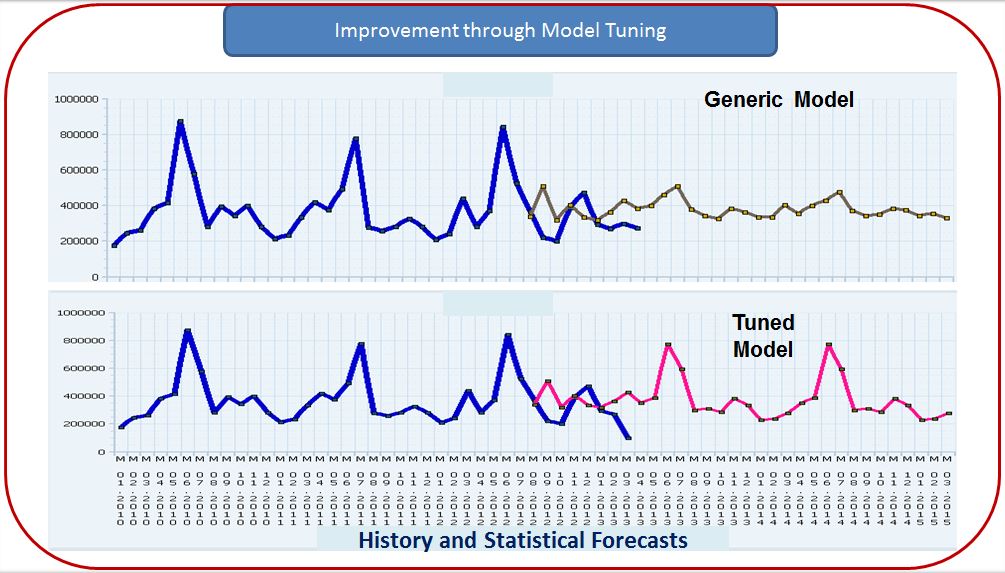Sailing through the SAP APO Ocean
As we all know SAP is an Ocean where the chance of getting lost is quite high.
Below are key takeaways from my experience while working on SAP Demand Planning projects.
While reading this article you may find uncanny resemblances to movie titles and dialogues. The pun has been intended.
- Silence of the stats
Almost for all the clients, we have witnessed an “Ahaa” moment when we show them their own data and how beautifully a tuned stat model can work. We all love before and after picture. Here is an example
Tuned Stat Model
In our opinion, planners should have the ability to edit history. This is your input to the APO engine to populate the stat forecast, so if garbage in garbage out!
Remember with great power comes great responsibility. Extreme values can make the forecast unstable. Here is where demand planners have to combine art and science. Science is about getting comfortable with the Greek alphabets, a world of alpha, beta, gamma, and phi. After you tune the stat model, the art part comes in. You need to incorporate intelligence.
With all these powerful features of the statistics in APO DP, now comes the greater part of handling it responsibly.
- Process Unchained!
Working meticulously during the wee hours of the night when the planners are sleeping to make sure they get the right set of numbers, is really a commendable effort.
But why? If the system has the flexibility to run Process Chains, which connect one successful step to the other, one should invest their resources in streamlining the auto-execution of jobs.
- Silver Linings Planning Books
All implementations are complicated and give jitters to the implementation team. Folks are so immersed in the intricacies of the APO design that they forget the simplicity that the business is demanding for. (By lacking simplicity we may make Dr. Lecter unhappy)
Demand planning is both art and science. We need to reflect on this philosophy while working on the design. Again this is not a golden rule and will definitely change from a business perspective. For some companies, demand planners are structured around customers while for others it’s by geographical regions or by-products. We need to keep such uniqueness in mind while designing the planning books.
Below is such one such example of a data view –
Planning Book Building Blocks
- SAP Alerts: Mission Impossible
First things first, “not being able to save and see the right set of key figures needed for such diagnostics calculations”, is I think a key issue here.
By now we all know how APO struggles to calculate MAPE, if it has very low or zero historical observation. Thus, by using MAPE you will end up managing by incorrect exceptions.
Does MAPE of 200% really mean a bad statistical model? Should I really focus my attention on how to drop such 200% MAPE to a certain threshold? Are the efforts even worth the try? We have resolved such questions through dedicated stat modeling sessions as part of our project.
Again not a golden rule, Should I look at MAPE …? Yes…! Should I look only at MAPE…? Absolutely not! Then we have left with scale-dependent metrics like MAD and RMSE. And here is where the analytics part comes into play. A different business group within a company cannot have the same MAD thresholds as it is scale-dependent.
Making alerts possible also ties back to a structured process chain. Depending on the business needs some alerts we will have to execute on daily basis (e.g. tracking the demand compared to the forecast). Because we don’t want to see stale alerts, we also want to delete old alerts.
The Most tricky of them all is, calculating forecast error alerts.
A good practice is to measure your performance with respect to a lag forecast e.g.2 month or 3-month lag depending on your business and specific lead times.
Here is a list of clients we have worked with in the past –
Partial List of clients
Contact us if you have any comments or questions. Meanwhile, you can explore additional information on SAP APO Usability at http://demandplanning.net/SAPAPODownload.html
Please visit http://demandplanning.net/consulting.htm to know about our services offerings at DPLLC.
Follow Us to keep updated on our regular content in the SCM space -





Leave a Reply